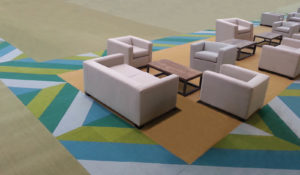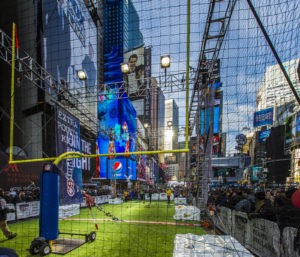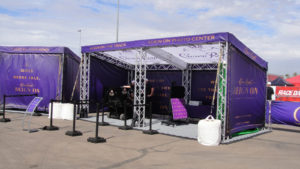
Flooring providers and tented-event pros offer tips to help you step up your tent flooring game.
Tents are designed to protect from above. The flooring underneath them, however, is just as important. The right flooring solution can give an event the additional panache it needs to make a lasting impression. Modular subflooring and customized top covers are in demand for all types of events, and new products are designed with labor-saving and ease of handling in mind. From dance floors to stages to multi-level platforms on uneven ground, tented-event professionals have more diverse options than ever.
Make a choice
Several variables affect flooring choices for tented events. Based in Orlando, Fla., Jerrod Albright, sales manager of ATC, a division of Signature Systems Group LLC, determines the customer’s goals before making recommendations. “Most customers don’t know exactly what they need, so they rely heavily on our expertise,” he says. “We take the time to get an overall perspective of what the client is trying to accomplish. If it’s a public arts festival, we wouldn’t use the same materials that we would use for a private event.”
Albright classifies flooring in two categories: ground protection subflooring and top cover flooring. A different set of questions determines which product will be used in each category. “As far as subflooring goes, we need to know if it can be used on concrete, grass, sand or other surfaces,” he says. “We want to make sure the flooring is going to work on all different types of terrain.”

For top cover flooring, Albright asks more pointed questions about color schemes and custom branding options to determine the best material for the job. “We do a lot of custom branding,” he says. “We can make a logo rug that says anything the client wants.”
Allison Munsell, an event specialist with Ultimate Events in Plymouth, Minn., recommends a site visit before making product determinations. “We survey the land first to make sure we know if it’s going to be laid with the grade of the land or if we have to build up a floor,” she says. “We have five different flooring options for different terrain, so we can create flooring for any location.”
James Zacharias, national director of client experience at flooring solutions provider Brumark, based in Atlanta, Ga., asks a series of questions to get to the heart of what his customers want and need.
“The first question I ask is ‘What’s the budget?’ From there I can limit the options,” he says. “Then I ask what they want to put on top of the flooring, what kind of surface will it be installed on and whether or not it will be exposed to the elements. I also ask questions about aesthetic and ambiance. Do they want the floor to be comfortable or rugged? If they want something eco-friendly, that also helps me focus on a solution.”
At Ultimate Events, the final decision about what type of flooring to use is made with input from both the sales and production sides of the business, Munsell says.
“Some decisions are more heavily influenced by how suitable the product is for the location and others are more heavily influenced by the specific requests of the client,” she says. “If the location requires scaffolding or other height requirements, we are limited to the products that can meet those demands.”

event flooring. Photo courtesy
of Signature Systems Group
Tips and Tricks
A tent floor is only as good as its installation. Safe and efficient installations depend on having the right products, tools and experience.
Modular flooring is one of Albright’s go-to solutions. “There are different types of subfloors, including jack-style floors that you can lay plywood on,” he says, “but we specialize in modular flooring that snaps together. We can install 30,000 square feet in a quarter of the time it would take to do a plywood floor. We can also get more square footage in a truck for delivery.”
Albright also recommends the use of skilled labor. “People think they can save a buck by hiring someone they know or local labor to come in and do [the job],” he says. “It is important for us to use our crew. We employ people who are experts, and we make them experts with our training. We don’t want someone who doesn’t have experience knowing where to make the right cut, how to start an installation, etc.”
During the quoting process, he recommends the use of a transit level to get an accurate understanding of differences in elevation. When he knows the site conditions, Albright can direct a customer to the right product and be prepared with the right tools on installation day.
Munsell also emphasizes the importance of using the right product, especially at sites with limited access. For example, Ultimate Events uses EventDeck® modular flooring (from Signature Systems Group) for installations where a truck can’t be driven up to the site. This type of flooring is a popular option for weddings and other private events that are on a budget but want a solid flooring solution, she says.
Jesse Hessong, owner of Intriguing Solutions, Fayetteville, Pa., has installed flooring for events across the United States. One of his go-to tricks for uneven surfaces is to lay down a substrate before putting down flooring. “Sometimes I use gravel or stone so it can be cleaned up off of grass,” he says. “More commonly, on surfaces like parking lots, I lay down a sheet of plastic, pour Quikrete® on it, and let it set overnight. I then have a hard, level surface to lay flooring on, and it can be easily cleaned up after the event.”
In an effort to save time and money—and prevent backaches—Hessong invented Event Key™, a hand lock tool that allows installers to level modular flooring components while standing. “Installing modular flooring normally requires a lot of bending over,” he says. “Event Key lets you lock flooring from a standing position.”
A new magnetic flooring product from Brumark, Magnitude™ Raised Flooring System, also promises to save time and labor. The custom vinyl panels attach to the floor with a magnetic backing and can be applied in a matter of minutes, Zacharias says. The panels are designed for high traffic and commercial use and require no adhesives.

White and wood
Clients want more than generic turf for tented events. Custom carpets and laminate flooring options that feature company logos, personal messages and designer color schemes are preferred.
Munsell has noticed more demand for wood or woodlike flooring for tented events. “All kinds of events are requesting it, but especially social events, including weddings and galas,” she says.
White flooring and custom branding are the trends with Zacharias’s clients. “Everybody wants white right now,” he says. “Dance floors, carpeting, stages, people want it all to be white at their events. Many people are also customizing their flooring with branding and logos. It could be custom printed vinyl, logo-inlay carpet or water-jet inlaid LVT.”
Albright sees a trend toward a more wide-scale acceptance of laminate and rolled vinyl flooring options. “A lot of the event companies are stepping up their game by making their bids more attractive,” he says. “It’s about figuring out what your customer is trying to accomplish and helping them do that. People are willing to pay for [custom flooring] if they are confident you can provide them with exactly what they have
in mind.”
For clients concerned with cost savings, Munsell has seen a trend in the use of dance flooring in place of more traditional options. “The cost to build a floor and put [a covering on it] is usually two or three times the cost of the tent rental itself, so I have found that laying down dance floor under the tent tends to be less expensive for the customer,” she says. “It kills two birds with one stone because it is an already finished-looking product. It does require a reasonably flat surface, however.
It won’t lock into place properly if there is
significant topography.”
New technology brings exciting and useful options to the industry. Today’s flooring choices offer event professionals more ways that ever to personalize events and satisfy their customers, while saving time and labor with products designed for efficient installations.
Jake Kulju is a freelance writer based in Minneapolis, Minn.
 TEXTILES.ORG
TEXTILES.ORG


